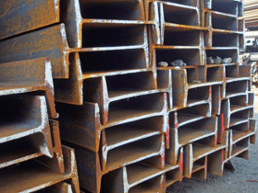Steel Beam Basics – How to Buy Steel Beams
Carbon steel beams come in a variety of different forms and specifications to suit countless industrial applications. At Continental Steel & Tube, we know that it can be difficult to navigate through the myriad of beam options to find the right one for your particular project. You can narrow the choices down simply and easily, however, by focusing on your major requirements. Typically, this includes elements like shape, grade and size.
Carbon steel beams come in a range of shapes. The shape of a beam affects its strength, weight and ultimate cost. Most applications call for wide flange beams, which are also somewhat ambiguously called I-Beams, H-Beams or W-Beams. Wide flange beams are characterized by broad flanges on either side of the web. In rare instances, some projects call for a standard American beam, also known as an S-Shape I-Beam, which features a curved profile. Wide flange beams and standard American beams have a proven ability to withstand bending and shear loads, and are commonplace in the construction industry.
The next consideration is grade. Most mills produce wide flange beams to a dual specification of ASTM A992 and A572 GR 50. ASTM A992 is the new industry standard and requires carbon steel beams to be constructed from stronger material than in the past. As a result, it is less common to find wide flange beams with the old ASTM A36 spec. Some mills may still offer S-Shape I-Beams with this specification today, but these are gradually being phased out in favor of beams with the newer, stronger standard.
A last important concern is size. The size of a wide flange beam follows the letter W. Following the size is the section number, which gives you the nominal depth. Next comes the pounds per lineal foot of beam, and then the length. For example, a beam with a size of W12 x 50 x 40 has a height of 12 inches, a weight of 50 pounds per lineal foot, and a length of 40 feet; according to the figures, this beam will weigh 2,000 pounds. You can determine the size of an S-Shape I-Beam in the same way. The only difference is that the letter W is replaced with the letter S, to indicate the different beam profile. Understanding the size system for steel beams will help you calculate the weight and cost per piece.
It can be a challenge to find the most appropriate beam for a project. At Continental Steel & Tube, we’ve compiled a list of common wide flange beam and S-Shape I-Beam sizes that you can easily download from our site.
As experts in the field, we can supply you with rarer, large beams and transport them directly to your job site. Our value added services include cutting to length, hot dip galvanizing, priming, welding base plates, and burning mounting holes.
Please contact us today to discuss your beam requirements and get your project off the ground.








